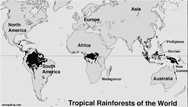Introduction
Module aims
Welcome to Module 3. The aim of this module is to introduce you to the fundamental ecological properties and biogeography of the world’s tropical rainforests, with an emphasis on Australian rainforests. Rainforests are highly diverse and provide a wide range of ecosystem services, however, they are under threat. In order to explore this issue, as with the savanna module, ecosystem characteristics and determinants will be examined as well as land management activities and their impacts on ecosystem processes.
The module is organised under the following topics;
- Fundamentals of rainforest ecology
- Rainforest diversity, disturbance and gap-phase dynamics
- Australian rainforests – an overview
- Threats to rainforest ecosystems
- Case studies – Fire management in the Amazon
Like the other modules, a range of Activities has been proposed with short-answers provided.
When you see this ![]() symbol you are being prompted to examine an issue and provide some thoughts on the Learnline Discussion Board. Go to this folder and see the Forums link.
symbol you are being prompted to examine an issue and provide some thoughts on the Learnline Discussion Board. Go to this folder and see the Forums link.
Introduction
Forests cover about one third of the earth’s surface, an area approximately three times that occupied by crops, underlining the significance of forest ecosystems to global patterns of climate, water resources and other ecosystem services. Tropical rainforests (Figure 1) represent the ‘greatest celebration of life on Earth’ (Norman Myers). They have long been home to indigenous peoples with rapid population explosion of non-indigenous in these regions over the last 100 or so years.
Tropical rainforest forest occurs in 4 main regions, central and west Africa, central and south America, South-East Asia and eastern Australia (Figure 2). These areas support 50% of the world’s known species ~ 10 million species (possibly up to 30 million) in 7% of the land surface area. Similarly, Australian rainforests compromise 2/3rd of the country’s biotic diversity in less than 1% of the continental area and there has been considerable controversy relating to their use and management over the last 40 years.
Although the conservation status of the Australian rainforest estate has dramatically improved over the last two decades, deforestation and degradation of rainforest continues in much of the Americas, Africa and Asian tropics and subtropics at a rate of approximately 100 000 km2 per annum. Such rapid changes in land use has local and global environmental, social and economic consequences and tropical forest management remains one of the most high profile land management issues in the world today (Navjot and Brook, 2006).

Figure 1 High biodiversity Amazonian rainforest.
Figure 2 Global distribution of tropical rainforests
(used with permission from http://photos.mongabay.com/en/
World_Map_of_Tropical_Rainforests.htm). Note the small areas occupied by rainforests in Australia.
Next topic - Fundamentals of rainforest ecology



